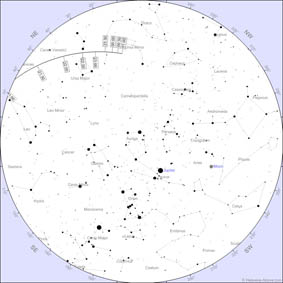
The Astronomical Observatory of the University of Valencia has developed a small, practical guide for the observation of the asteroid 2012 DA14, a small celestial body of only 60 meters traveling this Friday near the Earth and will be visible from Valencia with the aid of binoculars. At its closest approach, it will be less than 30,000 kilometers away from the Earth, well below the geostationary orbit.
2012 DA14 was discovered by the Astronomical Observatory of Mallorca from its facilities in the Serra de la Sagra, on 22 February 2012. It has been classified as an NEO Apollo-type asteroid, name that corresponds to stars that periodically cross Earth's orbit. This week it will pass so close to Earth that its orbit will suffer major disruption. Precise observations during its passage will be critical in determining its trajectory in future approaches the Earth.
Observing the flight of this little rock from Valencia and its surroundings will not be an easy task.
Due to its small size, at no time will it be visible to the naked eye, so you will need some optical aid. Furthermore, when it is clostest to Earth it will still not have risen from the horizon Still, for those who do not want to miss this rare and fascinating phenomenon that nature provides us, we have published a brief guide for observation.
The best instrument to observe 2012 DA14 are binoculars. A small telescope with a large field of view can also give us a good result, if we can handle it quickly and with expertise. We will need a cloudless horizon in the direction of the northeast and of course, the darkest conditions possible. The data presented below were calculated for the coordinates of the Observatory of the University of Valencia in Aras de los Olmos, although they can be regarded as valid for the whole province of Valencia.
The closest approach to Earth will occur at 20:26 official time. At that time, the asteroid will be 20 degrees below the horizon and therefore will not be observable. Its departure will occur half an hour later, at 20:57 official time. At the time of exit, it will be about eight degrees at the geographical north of Denébola (beta Leonis), the star at the Lion's tail, which will also be rising at that time.
A few minutes later, between 21:15 and 21:25, the asteroid will transit the cluster of Coma Berenices. For those who can enjoy a clear and transparent horizon, this is the best time for observation. With an elevation of between 10 and 15 degrees and a magnitude less than even the eighth, the rock will move over the rich and dense star field of this open cluster, still easily visible with binoculars.
At 21:48 we will easily find again the asteroid. At that time it will be less than one degree above the star Chara (beta Canum Venaticorum), the second brightest of the small constellation of the Hunting Dogs, located under Ursa Major. The object is then to 25 degrees above the horizon, with a magnitude of 8.4, still visible with binoculars although losing brightness appreciably now getting away from Earth.
Finally, at 22:30 official time, we will find 2012 DA14 crossing the spear of the Ursa Major among the stars Alioth (Epsilon Ursae Majoris), the last star of the spear, and Megrez (delta Ursae Majoris), the first wagon body. The magnitude of the asteroid will already be 9.2, starting to be hardly distinguishable. It will then continues its way, getting slower and weaker, between the constellations of the Draco, Ursa Minor and Camelopardalis, already visible only with medium to high power before getting definitely lost in space.
Last update: 14 de february de 2013 08:00.
News release



















